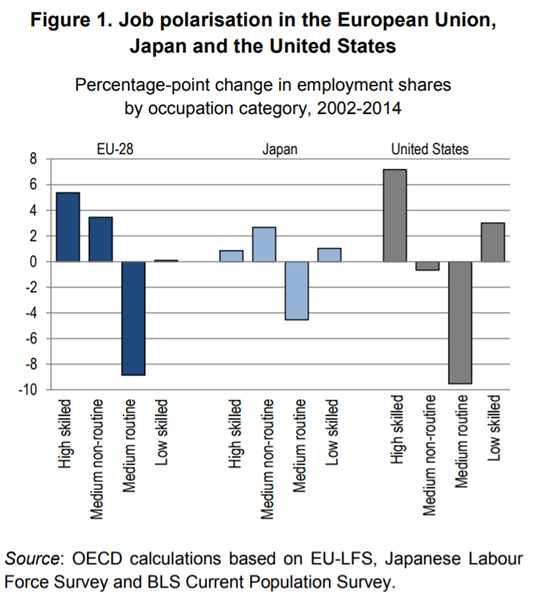Some confuse Jordan Peterson for being an optimist. He’s not. He’s a realist, and sometimes realism calls for optimism, and other times pessimism. For people with high IQs and STEM skills, now is time for optimism. College grads, particularity in STEM, fared the best in the years following the 2008 crisis. For those with average or below-average IQs, maybe not so much: high school grads and college dropouts fared the worst in terms of wage growth and employment. Dr. Peterson acknowledges this bifurcation, conceding multiple times that economic conditions pose unique challenges for individuals with low IQs. But it’s not just low-IQ people, but also average-IQ people and also those with IQs that are only modestly above average–or in statistics terms–plus or minus a single standard deviation from the mean–also face challenges.
A well-worn argument is that technology will eliminate low and medium-IQ jobs, but as discussed in the posts The Inescapable Pull of Biology and Technology and Job Loss: The Debate Continues, rather than technology eliminating all jobs, the trend is middle-income jobs for average-IQ people being replaced by low-paying jobs suited for below-average IQ people. The so-called ‘hollowing out of the middle’ (IQs of 95-115) is probably a bigger concern than that of left-side (<95), who have decent employment prospects in the low-paying service sector, which has rapidly grown since 2008.
The problem is the middle, those with IQs around 95-120, who are not smart enough to enter the upper-tiers of employment, so they find themselves in the same sort of jobs as the left-side, whereas decades ago there were better employment prospects for those people, such as in manufacturing, financial services, or trades work.If you have an IQ above 130, then are are a lot of high-paying, high-status opportunities, such as in STEM.
This is evident in the chart below, which shows a decline of middle-income jobs since 2002:

So how does this relate to men? The problem is, the rise of the service sector and decline of manufacturing hurts men and benefits women, the latter who are biologically better adapted for hospitality and other service sector work, whereas men are better suited for jobs that tend to be ‘hands on’ such as construction, farming, manufacturing, or truck driving. The decline of the male labor force participation rate parallels the decline of manufacturing and is inversely related to the rise of service sector:


The ‘invisible men’ are males who are left behind in this new economy, having dropped out of the labor force or are just ‘getting by’. They tend to have the following characteristics:
-are white, young or middle-aged (between the ages of 20-40)
-most have no college degrees, and those that do tend to have jobs that are not commensurate with their credentials; no advanced degrees
-come from middle or lower class families
-are of average intelligence (between 85-115 IQ)
-don’t have any ‘special’ or exceptional skills. They aren’t as eloquent as Jordan Peterson. They cannot code, and most aren’t smart enough to learn even if they wanted to.
-they excel at structured environments and following instructions, rather than creative work or self-actualization
-tend to indifferent or oblivious to most culture war issues. They don’t care or know what ‘intersectionality’ is, but they sense that things are headed in the wrong direction.
There are no online activists groups for these men…no #METOO or #BLM equivalents. No ‘solidarity’ or ‘identity’ in the same way that it’s socially acceptable for other groups to have identity.